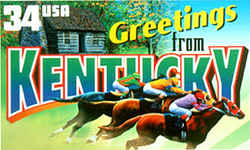
Kentucky Symbols
Kentucky State Center for Celebration of African American Heritage
The Kentucky Center for African American Heritage

Louisville
Adopted on July 15, 2002
Kentucky Center for African American Heritage is the official Center for the celebration of Kentucky's African American history and heritage. It was adopted on July 15, 2002.
The Kentucky Center for African American Heritage is the result of a collection of African American educators, artists and historians who have collaborated to give the long dormant history of African Americans in the region the voice and platform it deserves. This group evolved from the Louisville and Jefferson County African American Heritage Committee into its current mold, with a single unifying goal of promoting the Kentuckiana region's black heritage.
Kentucky State Center for
Celebration of African American Heritage:
The Kentucky Center for African American Heritage

The first reaction comes from the heart. You cannot help but be moved by the impressive façade. It is clear that this is an important place, a prideful
place, a place of enlightenment. Sleek new architecture, adorned with bold and colorful murals, meets the elegant Victorian details of an old trolley
repair shop. Banks of windows capture the sun and flood the interior with light. It is more than the sun that shines here - it is the light of truth,
the light of perseverance, the light from an inner fire that cannot be extinguished. This place is Romanesque Revival. It is modern reconfiguration.
It is inner-city revitalization. It is spiritual renewal.
This place is a testament to durability and endurance during a time when so much of our nation seems to celebrate the disposable, the quick fix, the
convenient. This place is a pause for reflection in the maddening rush of life, a place to remember what matters when we are bombarded by triviality.
This place is the Kentucky Center for African American Heritage, rooted in the past but reaching toward the future. It is a place that ensures that
the visitor knows what has gone before but also insists on preparation for what is yet to come.
The second reaction comes from the intellect. Logic dictates that we build it now. Here. There may be no more fitting location for African-American
history in Kentucky than the cluster of buildings at Muhammad Ali Boulevard and 18th Street. Beginning in at least the 1870s the site was an essential
part of the development of Louisville's public transportation. For many decades the city's streetcars, and later, its buses, were repaired and stored
here. Black men and white men often worked side by side. In Louisville, as in other American cities, streetcars played a pivotal role in early demonstrations
against racial discrimination. It was in 1870 that members of the Quinn Chapel African Methodist Episcopal Church organized what is believed to be
the first major local protest of unequal treatment - mule-drawn streetcars whose seats were off-limits to black citizens. A lawsuit over the discriminatory
policies led to a victory in federal court, and after some resistance the three local streetcar companies eventually gave in and allowed black passengers
to ride the cars.
The complex sits in the heart of the Russell neighborhood, named for Harvey Clarence Russell, a distinguished black educator who lived here in the
1920s. This was the first neighborhood in Louisville in which large numbers of African Americans were buying their own homes - some of which were quite
large and expensive.
315 Guthrie Green, Suite 400
Louisville, Kentucky 40202
Phone: 502-583-4100
Fax: 502-583-4112
Source: Kentucky Center for African-American Heritage
Kentucky Law
The law designating the Kentucky Center for African American Heritage in Louisville as the official Kentucky state center for celebration of African American heritage is found in the Kentucky Revised Statutes, Title 1, Chapter 2, Section 2.109.
TITLE I - SOVEREIGNTY AND JURISDICTION OF THE COMMONWEALTH.
CHAPTER 2 - CITIZENSHIP, EMBLEMS, HOLIDAYS, AND TIME.
2.109 Official center for celebration of African American heritage.
The Kentucky Center for African American Heritage in Louisville is designated as the official center for the celebration of Kentucky's African American
heritage.
Effective: July 15, 2002
History: Created 2002 Ky. Acts ch. 346, sec. 236, effective July 15, 2002.







